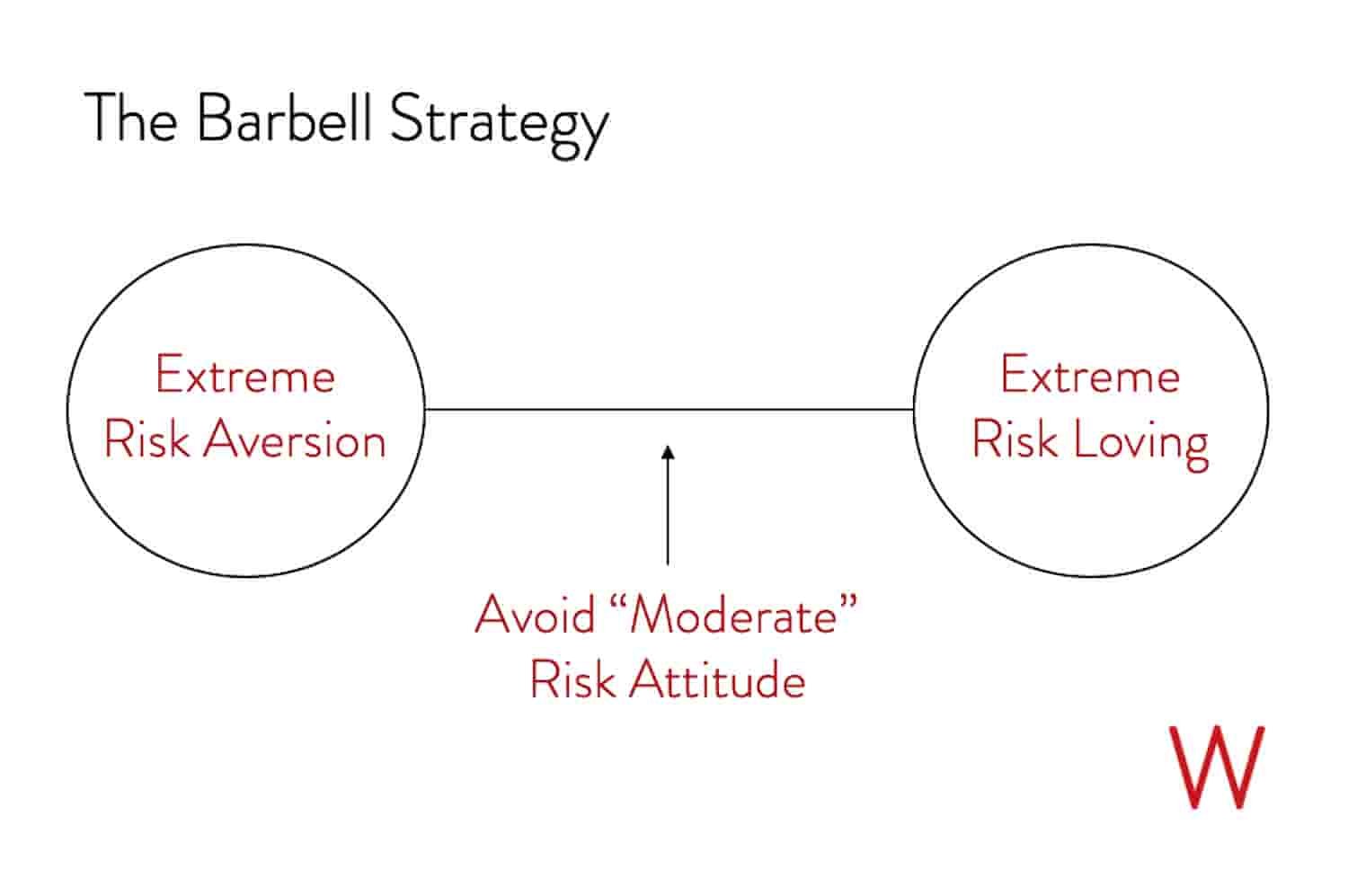Exploring The Barbell Strategy To Lower Risk and Increase Upside
Wealth creation is about looking for positive asymmetric opportunities - ones where the upside is many times greater than the downside. The Barbell Strategy is one way you can protect your downside risk while maximizing your upside potential.
What’s the Barbell Strategy?
The barbell strategy is an approach to uncertainty (risk) that uses two extremes - like weights on the opposite ends of a barbell - to avoid ruin and simultaneously expose yourself to a speculative upside.
On one end of the barbell is extreme risk aversion (safety). On the other end is extreme risk loving (speculation). What you avoid is the “middle” of the barbell - a moderate risk attitude that is highly prone to error.
Nassim Nicholas Taleb explores the Barbell Strategy in his books, Antifragile: Things That Gain from Disorder, and The Black Swan: The Impact of the Highly Improbable.
Here is Taleb’s definition from Antifragile:
Barbell Strategy: A dual strategy, a combination of two extremes, one safe and one speculative, deemed more robust than a “monomodal” strategy; often a necessary condition for antifragility.
And here’s a more straightforward definition from The Black Swan:
Barbell Strategy: a method that consists of taking both a defensive attitude and an excessively aggressive one at the same time, by protecting assets from all sources of uncertainty while allocating a small portion for high-risk strategies.
A rendering of Taleb’s “Barbell Strategy” for managing risk.
According to Taleb, on one end of the barbell, you are highly risk-averse and therefore robust to negative Black Swan events. Negative Black Swans are highly improbable events that can ruin you. You are robust to them because you have partially protected yourself from exposure. You are safe, while others are destroyed.
On the other end of the barbell, you are risk-loving and exposed to positive Black Swan events. Positive Black Swans are highly improbable events that help you. You take small risks that have tremendous upside. So when a positive Black Swan strikes, you win big.
In handling risk in this way, you become what Taleb calls “antifragile.” You are in a position to gain from chaos and disorder by exposing yourself to the upside while eliminating the risk of ruin.
Let’s look at some examples to clarify this barbell technique.
Examples of the barbell Strategy
Cash And Bitcoin
Suppose you have 90% of your net worth in cash. You store it in a high-interest savings account, protected from inflation.
With the other 10%, you invest in the highly-speculative crypto-currency, Bitcoin. Bitcoin is almost the riskiest asset you could buy. It’s highly volatile and could easily go to zero.
This 90/10 split is a barbell strategy. One end of your barbell is in extreme risk aversion (cash), while the other end is in extreme speculation (bitcoin).
What’s the worse that could happen to you? Bitcoin goes to zero. You lose 10 percent of your net worth, while the other 90 percent is still sitting safely in cash. With this approach, you can’t ever lose more than 10 percent. You have capped your downside.
Meanwhile, your upside is massive. Your speculative Bitcoin bet could return 1,000 percent with a positive Black Swan.
With this positioning, you avoid the middle area of the barbell, where risk is often incomputable. Here’s Taleb explaining this position in Antifragile:
“Someone with 100 percent in so-called “medium” risk securities has a risk of total ruin from the miscomputation of risks. This barbell technique remedies the problem that risks of rare events are incomputable and fragile to estimation error; here the financial barbell has a maximum known loss. For antifragility is the combination aggressiveness plus paranoia—clip your downside, protect yourself from extreme harm, and let the upside, the positive Black Swans, take care of itself.”
This 90/10 approach protects you from ruin while exposing you to the maximum upside. It’s a favorable asymmetric bet - the upside is greater than the downside.
Flying in Airplanes
Taleb gives us another example of the barbell strategy in the form of pilots and flight attendants. Instead of every airline employee taking a “cautiously optimistic” stance (in the middle of the barbell) on risky matters involving flight, Taleb writes:
“I prefer the flight attendants to be maximally optimistic and the pilot to be maximally pessimistic or, better, paranoid.”
This approach protects us from an adverse Black Swan event like a plane crash because the pilot is highly paranoid about such a thing happening. Meanwhile, the flight attendant is encouraged to assure us everything is all right while handing out cocktails.
The Life of Seneca
Seneca’s life is another example of the barbell technique. Taleb writes that Seneca, the Roman Stoic philosopher, initially lived an adventurous, highly active life. Then, he settled down to a life of writing, meditation, and philosophy. If he had combined these styles, he would have found himself in the middle of the barbell.
Seneca isn’t the only one to take this approach. Taleb writes:
Many of the “doers” turned “thinkers” like Montaigne have done a serial barbell: pure action, then pure reflection.
Summary of the Barbell Strategy
Taleb’s barbell strategy gives you antifragility. It maximizes your upside while protecting you from the ultimate downside (bankruptcy, death, etc.). It puts you into a position to gain from randomness, volatility, and uncertainty instead of being destroyed by it.
I don’t know about you, but that’s a position I want to be in.
If You Want More Ideas Like This, Follow Me On Twitter And Subscribe To My Newsletter:
—
Taleb, Nassim Nicholas. Antifragile: Things That Gain From Disorder (Incerto). Random House Publishing Group. Kindle Edition.
Taleb, Nassim Nicholas. The Black Swan: Second Edition: The Impact of the Highly Improbable (Incerto) . Random House Publishing Group. Kindle Edition.
The content contained in this blog represents only the opinions of the author. The content herein is intended solely for the entertainment of the reader and the author and should not be relied upon in making any decisions.




